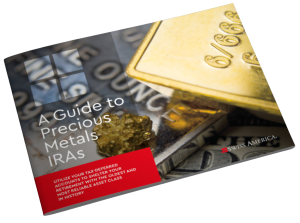Spot price is the current price at which traders can buy or sell gold. The terminology comes from the “on-the-spot” cost of one troy ounce of gold. It’s kind of like a wholesale price because it doesn’t include the additional costs of refining, minting, shipping, and dealer markups.
This article covers more details about what determines spot price and overall market impact.
Spot price versus premium
When you buy physical metal, you’ll notice the price is higher than the spot price you see quoted online. That difference is called the premium. It covers the cost of minting, distribution, and the dealer’s margin.
Premiums vary depending on whether you buy coins or bars, the size of what you’re buying, and overall demand in the market. For example, gold coins usually carry a higher premium than larger bars because they’re easier to sell in smaller amounts and more widely recognized.
| Aspect | Spot price | Premium |
|---|---|---|
| Definition | Current market price for 1 oz of precious metal | Extra cost above spot (minting, distribution, dealer margin) |
| Includes costs | No extra costs | Yes, includes production and dealer markup |
| Set by | Global commodity markets | Dealers, mints, and market demand |
| Changes | Constantly in real time | Varies by product type, size, and demand |
| Example | $2,300 per oz | +$120 → final price $2,420 |
Why do we have spot price?
The “spot price” is just the current going rate to buy or sell an asset for immediate delivery. Think of it as today’s live market value. For gold, that means what dealers and traders around the world are willing to pay for an ounce right now.
Because gold trades globally, the spot price stays fairly consistent once you adjust for exchange rates. That number is the benchmark everyone uses for anyone buying coins, bars, or even futures contracts tied to gold.
Spot price gives you a reference point to know if you’re getting a fair deal. It also drives the pricing of related products like options, ETFs, and futures. Businesses even use it when they hedge against market moves.
Basically, the spot price is the heartbeat of the gold market. It’s how you measure the immediate value of the metal and the foundation for almost every gold transaction.
How the market determines spot price
Spot prices get set in real time by supply and demand. Every time buyers and sellers make a trade, it helps determine the price “on the spot.” That’s why the number changes constantly throughout the day.
The spot price can move more quickly when there’s a lot of trading activity. On top of that, bigger forces like geopolitical events, inflation, or changes in the economy can cause investors to pile in or sell off, which directly impacts the price you see quoted.
Relationship with futures markets
The spot price sets the baseline for futures markets. Futures contracts for commodities like gold, oil, or wheat get priced by looking at the current spot price and then factoring in expectations about supply and demand, interest rates, and storage or carrying costs. It’s basically a future date type of investment.
Sometimes, future prices run higher than spot prices, which is called contango. Other times, they sit lower, known as backwardation. Either way, as the contract gets closer to its expiration date, the futures price and the spot price tend to meet in the middle. That’s what creates trading opportunities for investors who follow both markets.
Factors that affect market prices
Spot prices react to what’s happening in the world. Wars, inflation, and supply chain problems can all change the balance of supply and demand. Currency swings also have an impact since people buy gold in U.S. dollars, and buyers overseas adjust what they’re willing to pay when the dollar rises or falls.
Sometimes it’s the unexpected scenario that moves prices most quickly. A political shock, a natural disaster, or a sudden shift in demand can send the spot price up or down in a hurry. This is why prices can feel volatile, since they reflect market activity plus the broader global picture at that moment.
The role of commodity exchanges
Gold, silver, platinum, and palladium trade on exchanges such as COMEX in New York. The constant buying and selling on these markets is what sets the spot price you see quoted.
Most of the COMEX contracts never result in anyone taking home metal. Over 90% close out in cash, because traders use them to speculate on prices or hedge positions rather than arrange for physical delivery.
Finding and using market data
You don’t need special access to track spot prices. Financial news sites, brokerage platforms, and even a quick Google search will show you live market quotes while markets are open. If you want more context, dedicated trading platforms might have an interactive chart that lets you see price history and market overviews.
For investors, this data helps you see trends, compare options, and decide when it makes sense to buy, sell, or hold. It’s one of the simplest tools you can use to manage risk, stay updated and review what’s happening.
Final thoughts on spot price
Most investors add gold to their portfolios as a way to protect wealth and diversify. If that’s your goal, the spot price isn’t what matters most. Gold works best as a long-term asset, not something you try to time for short-term gains.
To learn more about investing in gold or other precious metals, reach out to the Swiss America team for guidance, resources, and how to get started.
Spot price: FAQs
What is spot price and forward price?
Spot price is the current market price you can buy or sell a commodity. Forward price is an amount agreed today for a future transaction.
What is the highest gold price in history?
As of this writing, the highest gold price is $3,500.05 per ounce, reached in April 2025.
